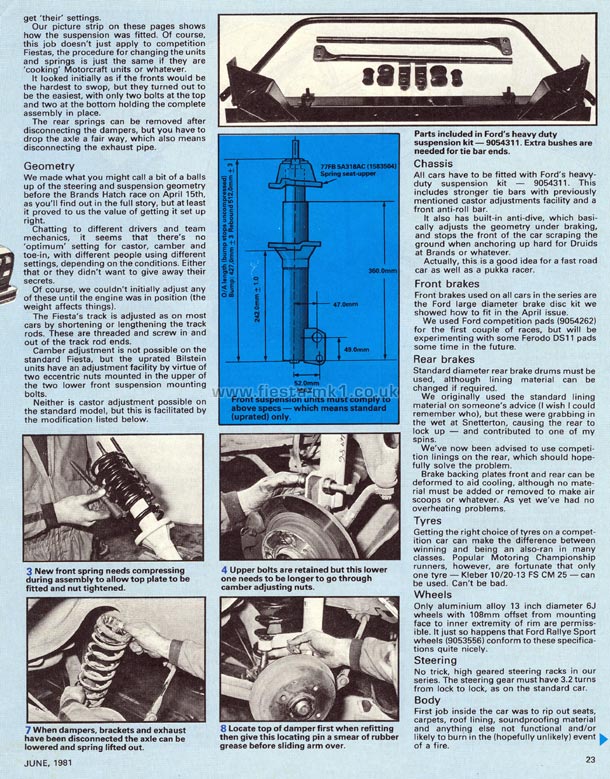Copy of Article Text Below
.....get 'their' settings.
Our picture strip on these pages shows how the suspension was fitted. Of course, this job doesn't just apply to competition Fiestas, the procedure for changing the units and springs is just the same if they are 'cooking' Motorcraft units or whatever-It looked initially as if the fronts would be the hardest to swop, but they turned out to be the easiest, with only two botts at the top and two at the bottom holding the complete assembly in place.
The rear springs can be removed after disconnecting the dampers, but you have to drop the axle a fair way, which also means disconnecting the exhaust pipe.
Geometry
We made what you might calf a bit of a balls up of the steering and suspension geometry before the Brands Hatch race on April 15th, as you'll find out in the full story, but at least it proved to us the value of getting it set up right.
Chatting to different drivers and team mechanics, it seems that there's no 'optimum' setting for castor, camber and toe-in, with different people using different settings, depending on the conditions. Either that or they didn't want to give away their secrets.
Of course, we couldn't initially adjust any of these until the engine was in position (the weight affects things).
The Fiesta's track is adjusted as on most cars by shortening or lengthening the track rods. These are threaded and screw in and out of the track rod ends.
Camber adjustment is not possible on the standard Fiesta, but the uprated Bilstein unite have an adjustment facility by virtue of two eccentric nuts mounted in the upper of the two lower front suspension mounting bolts.
Neither is castor adjustment possible on the standard model, but this is facilitated by the modification listed below.
Chassis
All cars have to be fitted with Ford's heavy-duty suspension kit - 9054311. This includes stronger tie bars with previously mentioned castor adjustments facility and a front anti-roll bar.
It also has built-in anti-dive, which basically adjusts the geometry under braking, and stops the front of the car scraping the ground when anchoring up hard for Druids at Brands or whatever.
Actually, this is a good idea for a fast road car as well as a pukka racer.
Front brakes
Front brakes used on ail cars in the series are the Ford large diameter brake disc kit we showed how to fit in the April issue.
We used Ford competition pads (9054262) for the first couple of races, but will be experimenting with some Ferodo DS11 pads some time in the future.
Rear brakes
Standard diameter rear brake drums must be used, although lining material can be changed if required.
We originally used the standard lining material on someone's advice (I wish I could remember who), but these were grabbing in the wet at Snetterton, causing the rear to lock up - and contributed to one of my spins.
We've now been advised to use competition linings on the rear, which should hopefully solve the problem.
Brake backing plates front and rear can be deformed to aid cooling, although no material must be added or removed to make air scoops or whatever. As yet we've had no overheating problems.
Tyres
Getting the right choice of tyres on a competition car can make the difference between winning and being an also-ran in many classes. Popular Motoring Championship runners, however, are fortunate that only one tyre - Kleber 10/20-13 FS CM 25 - can be used. Can't be bad.
Wheels
Only aluminium alloy 13 inch diameter 6J wheels with 108mm offset from mounting face to inner extremity of rim are permissible. It just so happens that Ford Rallye Sport wheels (9053556) conform to these specifications quite nicely.
Steering
No trick, high geared steering racks in our series. The steering gear must have 3.2 turns from lock to lock, as on the standard car.
Body
First job inside the car was to rip out seats, carpets, roof lining, soundproofing material and anything else not functional and/or likely to burn in the (hopefully unlikely} event of a fire......
3 New front spring needs compressing during assembly to allow top plate to be fitted and nut tightened.
4 Upper bolts are retained but this lower one needs to be longer to go through camber adjusting nuts.
7 When dampers, brackets and exhaust have been disconnected the axle can be lowered and spring lifted out.
8 Locate top of damper first when refitting then give this locating pin a smear of rubber grease before sliding arm over.
Captions -
Top-Right - Parts included in Ford's heavy duty suspension kit - 9054311. Extra bushes are needed for tie bar ends.
Middle - Front suspension units must comply to above specs - which means standard (uprated) only.
|



